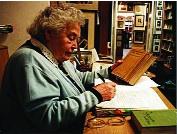Ethnic cleansing
Published in 20th-century / Contemporary History, Issue 4 (Jul/Aug 2008), Letters, Letters, Revolutionary Period 1912-23, Volume 16
The late Maureen Kenny. (Galway Advertiser)
Sir,
—Writing from Cork (HI 16.2, March/April 2008), CliveSinclair-Poulton embraces the view that more needs to be taught on whathappened in the 1920s and he reckons that there should be no taboos. Isay Amen to both propositions. A good place to start might be tworecent (March and April) obituaries in the Irish Times, one for thebookseller Maureen Kenny, a native of Mohill, Co. Leitrim, and one forthe late president, Patrick Hillery, the son of a dispensary doctor inMiltown Malbay, Co. Clare.
Maureen Kenny was born in 1918 and was but three years old at the timeof the Anglo/Irish Truce of 1921. Before reaching that age, on a coupleof occasions she was used as a human shield by the Black and Tans, whocarried her on a tender whilst they discharged their rifles at randominto the houses of her neighbours. Dr Hillery was born in 1923, but acouple of years previously his parents’ home was burned to the groundby the Black and Tans. The political context is that from Leitrimsouthwards through to Clare, and on to Kerry and Cork, the electoratehad supported Sinn Féin in the 1918 general election. Everyparliamentary seat in the province of Connacht was gifted or ceded toSinn Féin, and every seat but one in the province of Munster. Waterfordreturned a Redmondite nationalist to parliament, the sole non-SinnFéiner returned in the provinces of Connacht and Munster.
Late in 1920 Major Bernard Montgomery was posted to Cork to suppressdemocracy there. His British biographer, Nigel Hamilton, in asympathetic portrayal, quotes Monty as saying that he did not care howmany houses were burned by Crown forces in order to defeat Sinn Féin.Mr Clive Sinclair-Poulton writes of ‘a sustained campaign ofdestruction of Ascendancy country houses’ by Republicans, but fears toface the fact that such destruction followed rather than pre-dated thesustained campaign of destruction of the town and country houses ofnon-Ascendancy folk, and their businesses, farms, creameries and shops,by Crown forces. Unlike the Ascendancy, few commoners possessed bothtown houses and country seats.
Major Montgomery was himself of the Ascendancy, his family keeping ahouse in London and another in Moville, Co. Donegal. On leave frommilitary duties in Palestine in the 1930s, suppressing Arab resistanceand blowing up Arabs’ houses, he rested, sported and played unmolestedin Moville. During the Second World War Monty’s mother, who chose tospend it in Moville, habitually ran, unmolested, along the western,non-belligerent, bank of Lough Foyle, waving a giant Union Jack asBritish naval vessels passed into and out of Derry, whose nationalistmajority would have been arrested or beaten up by Crown forces had theydared to display the Irish tricolour. Some 30 years later, to maintainthe Ascendancy, Crown forces were to baton pro-democracy demonstratorsoff the streets of Derry or shoot them down like dogs.
Am I right in imagining that the term ‘Ascendancy’ could be fairlyrendered ‘Ubermenschen’ in German, and that we may infer that MrSinclair-Poulton deems the rest of us ‘Untermenschen’ and deserving ofwhatever treatment our betters think good for us? The tenor of hisletter suggests that I am.
—Yours etc.,
DONAL KENNEDY
London
















